The iPad Air Review
by Anand Lal Shimpi on October 29, 2013 9:00 PM ESTiPhone to iPad: CPU Changes
Although the iPad Air uses the same A7 from the iPhone 5s (and M7 motion coprocessor), there are a few minor differences that do lead to better performance.
At a high level we’re still talking about two 64-bit Apple Cyclone cores with 128KB L1s (64KB I$ + 64KB D$) per core, a shared 1MB L2 cache and a 4MB L3 cache that services the entire SoC. Apple increased CPU frequency from 1.3GHz to 1.4GHz in the iPad Air, a mild increase but in line with what we’ve seen from previous iPad designs. That’s the first impact on performance - a 7.69% increase in CPU frequency.
The second impact on performance is something I only noticed while digging around under the hood of the A7. It seems like the implementation in the iPad Air can, for whatever reason, hold more instructions in flight (over 20% more) than the A7 in the iPhone 5s. It’s unclear to me whether the A7 in the iPad is configured any differently via firmware/microcode or if perhaps we’re looking at a slightly different revision of the core, but the delta was repeatable in my testing.
The third, and likely biggest change impacting the iPad Air’s implementation of the A7 is the additional thermal headroom afforded by the larger chassis. I’m not going to go into details on exactly what this next test does (unfortunately we’re going to occlude some of the low level work that we do in light of all of the benchmark cheating going on), but we’re looking at a curve of performance vs. time for a particularly power heavy mix of code. We’re running the same exact code on both the iPad Air and iPhone 5s here, the only real difference is the size of the chassis:
You can see the 5s throttles back its CPU frequency to about 1GHz after the 2 minute mark. The crazy thing is that until that point the 5s manages to run at full frequency without so much as a hiccup for two full minutes, running an incredibly power hungry task. Given that most iOS apps aren’t this power intensive for such a sustained period of time, iPhone 5s users should almost always see the A7 running at a full 1.3GHz. Pretty crazy.
The iPad Air by comparison shows much more controlled behavior. Early on in the test we see a 7.7% performance advantage, which lines up perfectly with the iPad Air’s 7.7% CPU frequency advantage. By the end of the test the iPhone 5s has throttled to 900MHz, while the iPad Air drops to around 1.2GHz. At this point the iPad Air’s performance advantage grows to almost 40%.
CPU Performance
I've gone through our standard set of cross-platform browser based benchmarks to place the iPad Air's performance in perspective. As I mentioned in our 5s review, I don't know that there are many (any?) applications on iOS 7 that can really take advantage of all the A7 has to offer. There's definitely a ton of headroom left in the design. What's particularly exciting is when the A7 ends up in n-1 or n-2 iOS devices and it becomes the minimum developer target going forward.
I won't go through all of the results here again, but it's safe to say that the iPad Air is the fastest ARM based tablet on the planet at this point.
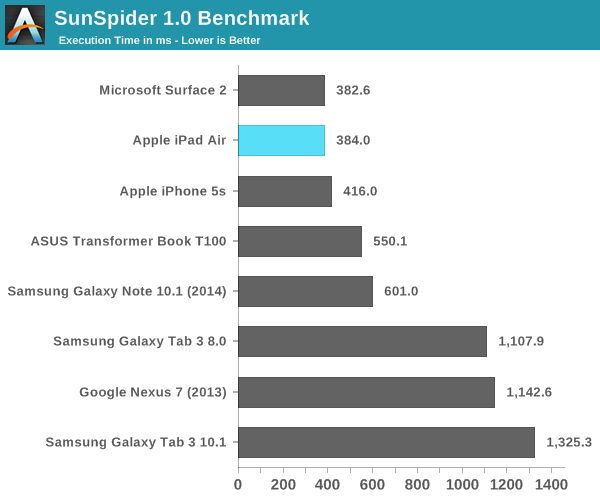
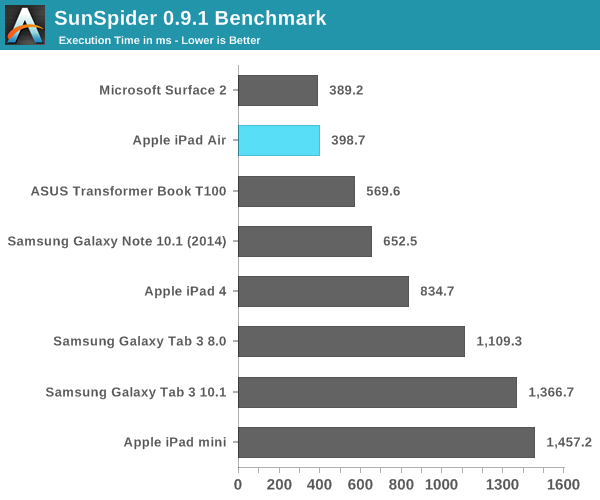
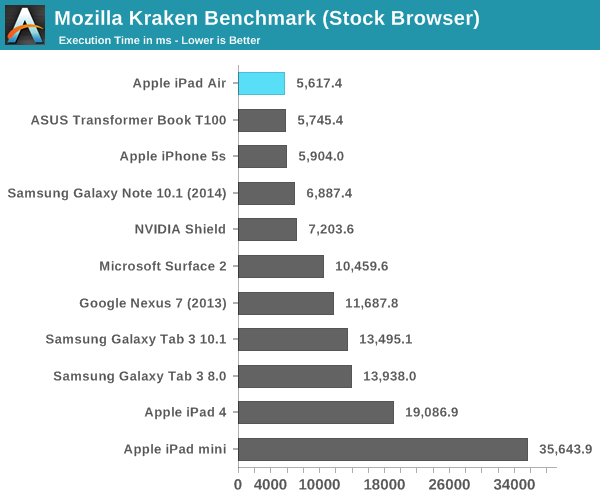
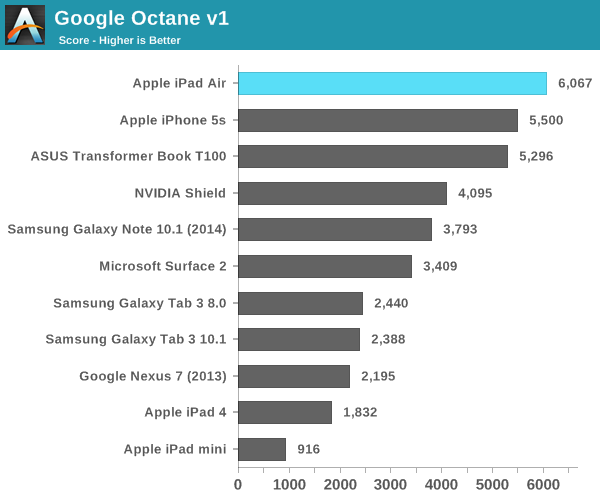
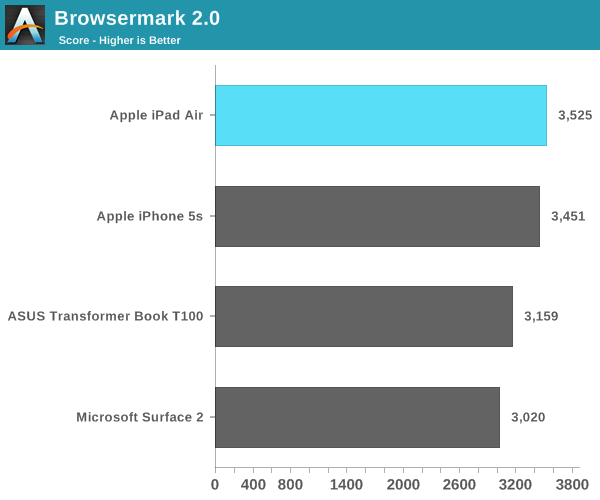

A7 Power Consumption
I’ll get to battery life in a bit, but I’ve been curious about the dynamic range of power consumption offered by Apple’s new A7 SoC. On the one hand we’re dealing with a lower power process (28nm vs. 32nm), but on the other hand Apple’s Cyclone cores can clearly draw more power given how beefy the architecture is this round. Apple frowns upon review sample dissection so I had to turn to a less scientific method of external platform level power measurement. The fidelity of the numbers here aren’t all that great but it’s better than nothing.
For the first test I measured platform power consumption during a Kraken run:
I purposely started measuring before the benchmark so I could get an idea of idle power consumption. The iPad Air consumes roughly 72% of the idle power as the iPad 4, both running at the same brightness. Here we’re not just seeing the A7’s advantages but also things like lower display power.
Focusing on the load portion of the measurement we see that both the new iPad and old iPad consume the same total power in this test. I suspect the A7 is drawing more power than the A6X, but it’s masked by a lower power display. Given how much faster the iPad Air is, Apple’s latest tablet features far lower overall task energy than the outgoing iPad 4. This is probably both the best case scenario for the iPad Air and the most likely case as well.
For kicks I wanted to see just how much power I could get the iPad Air to draw. Here I’m looking at platform power during our mini-power-virus test from above:
How’s that for dynamic range? Almost 12W running all out, but around half that in what we’d normally consider to be a stressful CPU test. I couldn’t get any actual applications/games on the iPad Air to behave like this so the results above are purely academic (for now). A quick run through GFXBench 2.7’s T-Rex HD test confirms that even pushing the GPU won’t hit these numbers. The max I saw running T-Rex offscreen was ~6W, and turning to an actual game (Infinity Blade 3) the iPad Air pulls less than 5W.


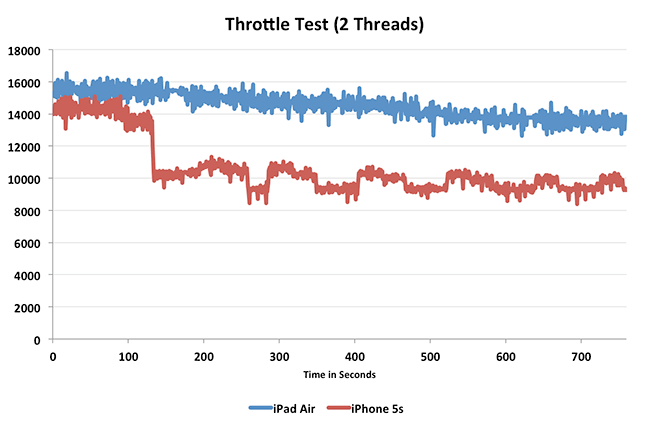
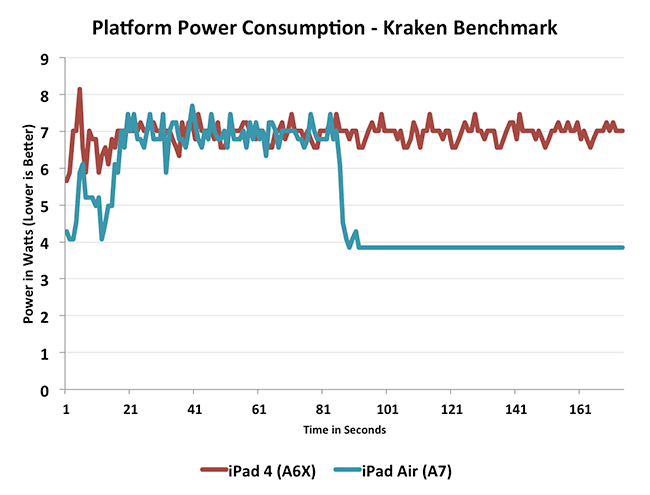
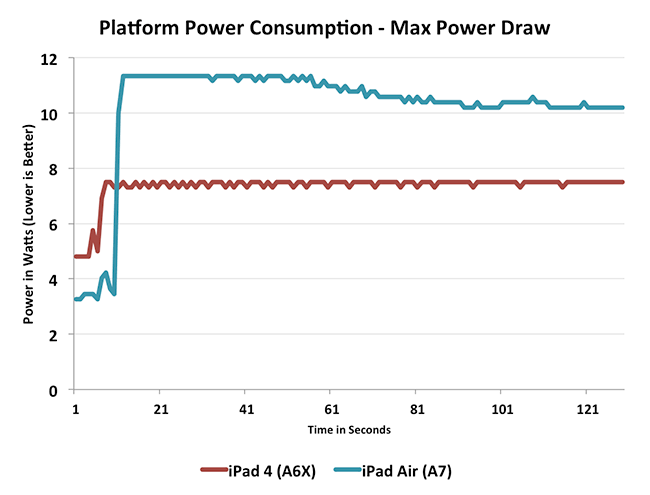








444 Comments
View All Comments
stingerman - Sunday, November 3, 2013 - link
Yes, I haven't even seen one of those in use other than commercials. Real failures...stingerman - Sunday, November 3, 2013 - link
lol, you're hilarious! iOS is Unix plus all the major OS X frameworks plus all the new iOS frameworks... It maybe light because of its elegance, but it's a light nuclear weapon...lilo777 - Sunday, November 3, 2013 - link
LOL. Do you know any version of Unix that does not have a file system (exposed to user)?Krysto - Friday, November 1, 2013 - link
Offtopic, but Anand, the announcement of Mali T760 is suspiciously missing from this site.Over 300 GFLOPS, which is more than PS3 and should make it pretty competitive with mobile Kepler, along with ASTC compression by default, much more efficient, and has some interesting features like hardware assisted global illumination.
ARM's announcement:
http://community.arm.com/groups/arm-mali-graphics/...
michael2k - Friday, November 1, 2013 - link
Yeah, the T700 series is for next generation devices, or in other words, products in the next 12 months. The PowerVR6 series is available now for this generation and up to 1000 GFLOPS.Krysto - Saturday, November 2, 2013 - link
Do you see that 1000 GBFLOPS in any smartphone? Just because it can be scaled that much, doesn't mean they WILL for smartphones. This GPU will be used in smartphones a year from now. What does the GPU in Apple's A7 have now? ~100 GFLOPS?Anyway, the Mali T760 seems very competitive with what will be out there a year from now, and Anandtech usually writes about these sort of announcements.
michael2k - Monday, November 4, 2013 - link
I think you've missed the point.1) We aren't in a smartphone thread
2) The PowerVR6 will scale to 1000 GFLOPs; so when the T700 comes out next year, the PowerVR will be ready
3) The Air is at about 115 GFLOPs, about 2x the outgoing iPad 4, and will therefore be approximately 230 GFLOPs in the A8 next year, if 2x, or 340 GFLOPs if 3x
So you are correct that the Mali T760 will be competitive next year, but this article is about this year.
michael2k - Monday, November 4, 2013 - link
You've missed the point.The PVR6 is 115GF today in the Air, and when needed to compete with the T700 can hit 300GF.
Likewise, we are in a thread about tablets, where it is much more likely to scale to the needed 300GF.
Krysto - Saturday, November 2, 2013 - link
What you said also reminded me of how Intel promoted "Haswell graphics"."Hey, look, out "Haswell GPU" (Iris Pro 5200) is 3x faster than IVB!" - and then you only see crappy 4600 in most devices, including the Surface Pro, which is only 20 percent faster than last year's IVB GPU.
Or "look at our awesome new 2.6 Ghz Silvermont CPU's! - and then you only see 1.3 ghz Silvemont for tablets, because the 2.6 Ghz ones are not viable either because of too high TDP or price, which makes them pretty irrelevant. What's relevant is what will be in the market, not their pie-in-the-sky CPU's that never get on the shelves.
ashleyuv - Saturday, November 2, 2013 - link
This is a very interesting review, even for someone without the tech or IT background to follow all of it. In particular, I like the way, in the last part, you show how the increase to 64-bit and the DRAM size (remaining the same), while seeming like a no-brainer and conservative decisions, respectively, are actually a smart play, albeit one with consequences.In agreement with one of your readers, I'd have to say that "review" is really the wrong word for this. It is all but a scientific study. But again, it's written for people who may not have an extensive tech background.
Thank you! I will be reading more in the future (just discovered your site).